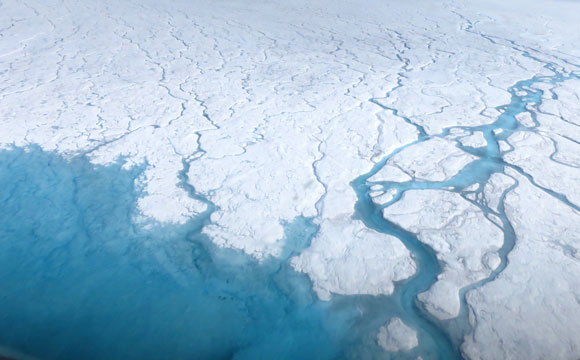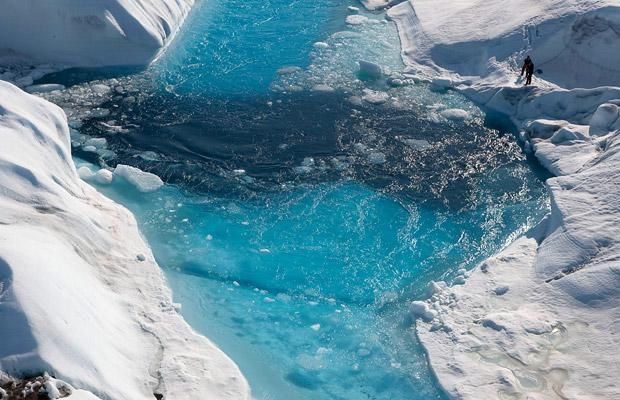
Streams and rivers that form on top of the Greenland ice sheet during spring and summer are the main agent transporting melt runoff from the ice sheet to the ocean. Credits: NASA’s Goddard Space Flight Center/Maria-José Viñas
Pakalolo
The Greenland ice sheet is the largest body of permanent ice in the Northern Hemisphere. Climate Change is happening swiftly in the Arctic, and consequently it is causing rapid and relentless melting of the sheet from both above (Albedo or dark ice) and below the ice due to warming ocean temperatures as well as large volumes of warm melt water at the bedrock). Most of us know that this run away melting is raising sea levels across the Globe. The hydrologic system of the Greenland ice sheet is extremely complex and there has been little data about how it works for some time. Slowly we are beginning to solve some mysteries.
Each summer, the hydrological system becomes activated as massive amounts of melt water produced on its surface, evaporates into the atmosphere, percolates into partially formed layers of ice, and feeds runoff into supraglacial lakes (a lake formed on top of the ice sheet), streams and rivers to the ice sheet margins.
Recently 2 sub-glacial lakes were discovered in Greenland. These lakes form below the ice and can stay unfrozen for decades. Particularly unusual is the fact that these lakes are associated with Antarctica and not the Arctic. They were unknown in Greenland until recently. The sub-glacial lake can be stable for decades, but can drain in one season and refill quickly with melt water from the surface.
We are familiar with the dramatic calving at marine terminating glaciers but what is less evident is the oddity of surface melting and what happens to the water for land terminating glaciers with it's sub and supra glacial lakes.

Scientists have discovered a crater, shown here, which had once been the site of a sub-glacial lake. Image credit: Ian Howat / DigitalGlobe Inc / Sci-News.com.
Recently, scientists have found direct evidence of concentrated, long-term storage and sudden release of melt water within sub-glacial lakes in Greenland.
One lake, described in the journal Cryosphere, once held billions of gallons of water and emptied to form a giant crater – 2 km across and around 70 m deep – in just a few weeks.snip
Dr Howat and his colleagues detected the crater on a spot about 50 km inland from the southwest Greenland coast earlier in 2014.There, previous aerial and satellite imagery indicates that a sub-glacial lake pooled for more than forty years. More recent images suggest that the lake likely emptied through a meltwater tunnel beneath the ice sheet some time in 2011.“The fact that our lake appears to have been stable for at least several decades, and then drained in a matter of weeks – or less – after a few very hot summers, may signal a fundamental change happening in the ice sheet,” Dr Howat said.Dr Howat’s group calculated that the lake that formed it likely contained some 6.7 billion gallons of water.And it disappeared in a single season – remarkably quickly by geologic standards. The scientists characterized the sudden drainage as catastrophic.“We suspect that, as more meltwater reaches the base of the ice sheet, natural drainage tunnels along the Greenland coast are cutting further inland. The tunnels carry heat and water to areas that were once frozen to the bedrock, potentially causing the ice to melt faster,” Dr Howat said.
The other sub-glacial lake, described in the journal Nature, has filled and emptied twice in the last two years.The Woods Hole Oceanographic Institution, describes a 1.5-mile-long supra-glacial lake in southwest Greenland, where the scientists first documented large-scale cracks and lake drainages:
Each time the lake fills, the meltwater carries stored heat, called latent heat, along with it, reducing the stiffness of the surrounding ice and making it more likely to flow out to sea.“If enough water is pouring down into the Greenland Ice Sheet for us to see the same sub-glacial lake empty and re-fill itself over and over, then there must be so much latent heat being released under the ice that we’d have to expect it to change the large-scale behavior of the ice sheet,” said Prof Michael Bevis of the Ohio State University, a co-author of the Nature paper.
Their study showed that in the 6 to 12 hours before the lake cracked and drained, the ice around the lake moved upward and slipped horizontally. The scientists say that meltwater had begun to drain through a nearby system of moulins (vertical conduits through the ice), which connected the surface to the base of the ice sheet 3,215 feet below. The accumulating water creates a bulge that floats the entire ice sheet, creating tension at the surface underneath the lake. The stress builds up until it is relieved by a sudden large crack in the ice below the lake.
“In some ways, ice behaves like Silly Putty—if you push up on it slowly, it will stretch; if you do it with enough force, it will crack,” said Stevens. “Ordinarily, pressure at the ice sheet surface is directed into the lake basin, compressing the ice together. But, essentially, if you push up on the ice sheet and create a dome instead of a bowl, you get tension that stretches the ice surface apart. You change the stress state of the surface ice from compressional to tensional, which promotes crack formation.”Once the tension initiates the crack, the volume of water in the lake does play a critical role, surging into the opening, widening and extending it, and keeping it filled with water all the way to base of the thick ice sheet. These are called hydrofractures, and the scientists have documented how they can drain more than 11 billion gallons of water out of North Lake in about 90 minutes. At times, water flowed out of the lake bottom faster than the water goes over Niagara Falls, the scientists estimated.“You need both conditions—tension to initiate the crack and the large volume of water to amplify it—for hydrofractures to form,” Stevens said. The key finding of this study is that without the former, even large supraglacial lakes will retain their water.

A 'whirlpool' and crack on the Petermann glacier. Geophysicist Dr Richard Bates, of the Scottish Oceans Institute at the University of St. Andrews, takes 'casts' of temperature, pressure, current and salinity. He makes casts - dropping a CTD probe (Conductivity Temp Depth) into the pool and pulling it back up at a slow speed...
Picture: NICK COBBING / GREENPEACE
The central mystery related to Greenland hydrology is how much melt water is lost to the ocean and thereby contributing to the rate of global sea level rise. Prior to late 2013, many thought that the bedrock under the ice sheet was relatively flat and that melt from inland glaciers would pond there and perhaps not contribute to SLR. "We now know that there are many channels in the bedrock. These channels potentially connects the interior ice-sheet, its plumbing, and melt water to Petermann Fjord".
Hidden under a mile of ice is a canyon that stretches for at least 465 miles from Greenland’s interior to its northwest coast at Petermann Fjord. NASA's Operation Ice Bridge found that parts of the canyon are a half mile deep and over 6 miles wide. The Grand Canyon in Arizona, for comparison purposes, is 277 miles long and over a mile at its deepest and 18 miles at it's widest. The researchers who discovered it have named it "paleofluvial megacanyon". Not a sexy name to be sure, but the name means that the "canyon was carved by an ancient river well before Greenland’s ice sheet covered it up some 3.5 million years ago".
Per NASA:
In their analysis of the radar data, the team discovered a continuous bedrock canyon that extends from almost the center of the island and ends beneath the Petermann Glacier fjord in northern Greenland.
At certain frequencies, radio waves can travel through the ice and bounce off the bedrock underneath. The amount of times the radio waves took to bounce back helped researchers determine the depth of the canyon. The longer it took, the deeper the bedrock feature."Two things helped lead to this discovery," said Michael Studinger, IceBridge project scientist at NASA's Goddard Space Flight Center in Greenbelt, Md. "It was the enormous amount of data collected by IceBridge and the work of combining it with other datasets into a Greenland-wide compilation of all existing data that makes this feature appear in front of our eyes."The researchers believe the canyon plays an important role in transporting sub-glacial meltwater from the interior of Greenland to the edge of the ice sheet into the ocean. Evidence suggests that before the presence of the ice sheet, as much as 4 million years ago, water flowed in the canyon from the interior to the coast and was a major river system."It is quite remarkable that a channel the size of the Grand Canyon is discovered in the 21st century below the Greenland ice sheet," said Studinger. "It shows how little we still know about the bedrock below large continental ice sheets."

Greenland’s bed-rock elevation from Bamber et al. (2003) digital elevation model based on remotely sensed surveys of the 1970ies and 1990ies gridded at 5 km resolution.
The blue color (below sea-level) at Petermann connect to the interior ice sheet’s blue.
"Oceanographic data are sparse, providing only a “snapshot” of conditions, and almost nothing is known about how the oceanography of the fjord varies over time – does warm water permanently circulate beneath the floating tongue? Does turbulence in the fjord help melt the ice?"
Climate Central notes the potential feedback loops. They are disturbing and grim.
Increased ice melt from this, as well as other surface melting due to increasing air temperatures could make Greenland a major contributor to sea level rise by the end of the 21st century. The melting of Greenland’s glaciers has also added a large boost of freshwater to the North Atlantic which could alter ocean currents and the ocean’s ability to take up carbon dioxide.
To be continued.
No comments:
Post a Comment